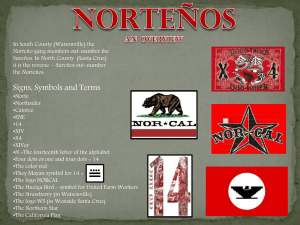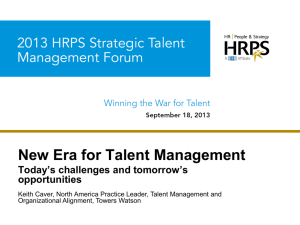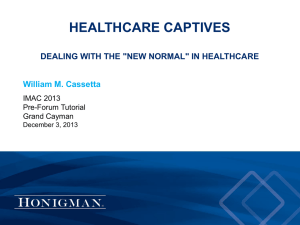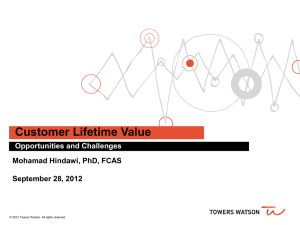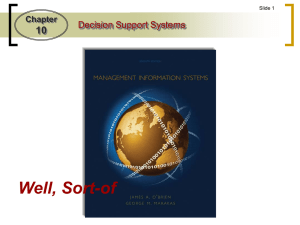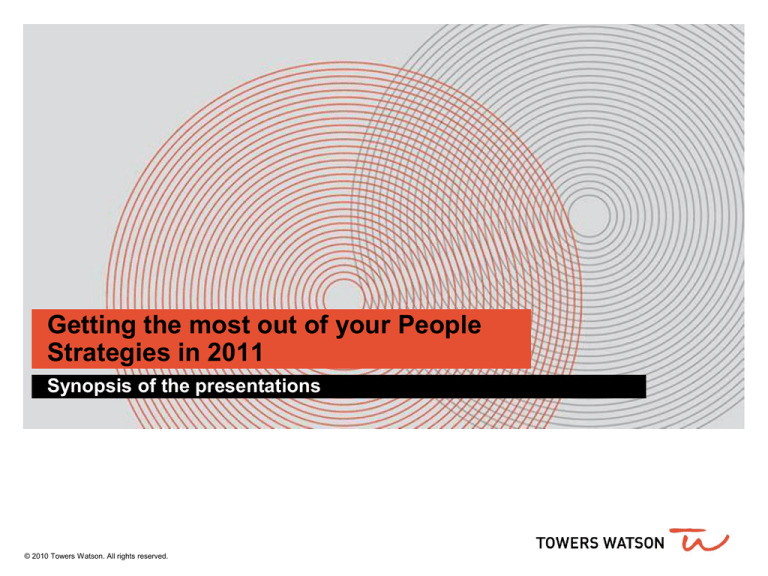
Getting the most out of your People
Strategies in 2011
Synopsis of the presentations
© 2010 Towers Watson. All rights reserved.
Our expertise
Helping organisations improve performance through
effective people, risk and financial management
Benefits
Talent and Rewards
Risk and Financial Services
• Retirement
• Executive Compensation
• Insurance Consulting
• Health and Group Benefits
• Talent Management
• Investment Services
• Rewards
• Reinsurance Brokerage
• Communication and
Change
• Financial Modeling
Software
• Employee Surveys
• Risk Management
• Global Data Services
Mergers and Acquisitions: From target evaluation to integration implementation
towerswatson.com
2
© 2010 Towers Watson. All rights reserved. Proprietary and Confidential. For Towers Watson and Towers Watson client use only.
Getting the most out of your People
Strategies in 2011
Overview of People Issues in 2011
towerswatson.com
© 2010 Towers Watson. All rights reserved.
© 2010 Towers Watson. All rights reserved. Proprietary and Confidential. For Towers Watson and Towers Watson client use only.
3
Hiring and Attrition are back…
India is once again witnessing increase in Hiring Numbers
Most companies are facing issues in hiring mainly at the middle management and
supervisory level.
Today's middle management challenge will become a leadership challenge in a few years
from now
With Growth back on the radar, so is Attrition
Better growth, better pay and personal reasons are the top three reason cited by
employees when leaving an organisation
We believe that internal factors like inequity of compensation or lack of differentiation are
likely reasons that contribute to the ‘push’
towerswatson.com
© 2010 Towers Watson. All rights reserved. Proprietary and Confidential. For Towers Watson and Towers Watson client use only.
4
Retaining top performers and keeping them engaged is
the top HR challenge in India
Source: Towers Watson HR Pulse Survey 2010
towerswatson.com
© 2010 Towers Watson. All rights reserved. Proprietary and Confidential. For Towers Watson and Towers Watson client use only.
5
Towers Watson’s View on Total Reward
A framework that captures all aspects of the work experience
TOTAL REWARD
Benefits
Pay
Base salary
Long-term sickness benefit
Bonuses
Pension
Recognition
Holiday
Allowances
Staff restaurant
Geographical and shift allowances
Relocation assistance
Life insurance
Career development
Leadership
Learning experiences
Culture
Performance management
Involvement
Succession planning
Diversity
Training
Work/life balance
Talent mgt.
Interesting meaningful work
Coaching
Job security
Learning and Development
towerswatson.com
Work Environment
© 2010 Towers Watson. All rights reserved. Proprietary and Confidential. For Towers Watson and Towers Watson client use only.
6
Medium Term Talent Management Challenges for India
Inc.
Productivity and
Cost
Management
Management of
Attrition
Effective Talent
Acquisition
Key Medium Term Talent
Management Challenges
Avoiding the
middle
management
trap
HR Service
Delivery
INTEGRATED HR PHILOSOPHY AND SYSTEMS
towerswatson.com
© 2010 Towers Watson. All rights reserved. Proprietary and Confidential. For Towers Watson and Towers Watson client use only.
7
Getting the most out of your People
Strategies in 2011
Are companies getting the most out of their Compensation and Benefits spends?
towerswatson.com
© 2010 Towers Watson. All rights reserved.
© 2010 Towers Watson. All rights reserved. Proprietary and Confidential. For Towers Watson and Towers Watson client use only.
8
Growth
Asia still driving global growth in 2011:
3.7
2007
2.0
2.6
1.7
0.4
0.6
Rising currencies
Commodity
prices/inflation
Asset bubbles
4.9
2010
2011
3.1
1.4
1.5
0.8
World
5.5
2009
-4.1
Concerns
8.3
2008
-2.2
-2.6
2.3
7.8
2.4
6.4
US
Euro Area
AP (excl. Japan)
Source: EIU Country Briefing Report, October 2010
towerswatson.com
© 2010 Towers Watson. All rights reserved. Proprietary and Confidential. For Towers Watson and Towers Watson client use only.
9
In 2010/11, Companies Expect Retaining Key Talent To
Get More Difficult, Especially In Asia-Pacific
Asia Pacific
80%
70%
60%
50%
40%
30%
20%
10%
0%
Now compared to prefinancial crisis
73%
57%
27%
25%
17%
2%
More difficult
towerswatson.com
One year from now as
compared to now
About the same
Less difficult
© 2010 Towers Watson. All rights reserved. Proprietary and Confidential. For Towers Watson and Towers Watson client use only.
10
% of responses
Most pressing challenges for HR in Asia Pacific
40%
37%
19%
20%
14%
22%
20%
16%
13%
13%
15%
0%
Controlling Cost
Biggest
Attraction & Retention
2nd Biggest
Improving Performance
Management
3rd Biggest
Source: Towers Watson 2009 Asia Pacific benefits trends survey report
towerswatson.com
© 2010 Towers Watson. All rights reserved. Proprietary and Confidential. For Towers Watson and Towers Watson client use only.
11
2010 – 2011 Salary Increases: General Industry
2010 - 2011 General Industry - Median Salary Increases
2010
14.0
12.0
10.0
4.0
11.5
10.3
10.0
10.0
9.0
8.4
8.0
7.0
8.0
7.0
5.5 5.5
5.0 5.0
6.0
5.0
4.0
3.5
12.9
11.9
11.0
10.0
10.0
9.6
6.0
2011
3.5
3.0
2.5
2.0
6.0
3.3
3.0
4.0
3.5
5.3
5.0
3.5
3.2
2.0
or
ea
M
al
ay
N
si
ew
a
Ze
al
an
d
Pa
ki
st
Ph
an
ili
pp
in
es
Si
ng
ap
or
e
Sr
iL
an
ka
Ta
iw
an
Th
ai
la
nd
Vi
et
na
m
K
pa
n
Ja
ia
ia
on
es
In
d
In
d
K
on
g
a
ia
hi
n
on
g
C
H
C
am
bo
d
h
es
la
d
an
g
B
A
us
t
ra
lia
0.0
Source: 2010 Towers Watson – Compensation Planning Report, October 2010
2011 Salary Increase presented are based on projected/forecasted figures shared by participating
companies
A total of 2,560 companies shared information for 2010 and 2,200 for 2011 General Industry figures
towerswatson.com
© 2010 Towers Watson. All rights reserved. Proprietary and Confidential. For Towers Watson and Towers Watson client use only.
12
Benefits preferred by employees in Asia-Pacific
% of responses
Source: Towers Watson HR Perspectives on Benefit Trends 2010
towerswatson.com
© 2010 Towers Watson. All rights reserved. Proprietary and Confidential. For Towers Watson and Towers Watson client use only.
13
Benefits challenges in Asia-Pacific
Irrespective of how much employers spend, some 40% of employees still don’t
really value benefits
% of responses
Source: Towers Watson HR Perspectives on Benefit Trends 2010
towerswatson.com
© 2010 Towers Watson. All rights reserved. Proprietary and Confidential. For Towers Watson and Towers Watson client use only.
14
Growing trend towards employee choice
More than one third of companies have or are considering implementing
choice
Traditional
73%
Employee choice
17%
Considering choice
15%
Statutory Benefits only
10%
Implementing choice
6%
0%
10%
20%
30%
40%
50%
60%
70%
80%
% of responses
Source: Asia Pacific Employee Benefit Trends 2009 (Towers Watson)
towerswatson.com
© 2010 Towers Watson. All rights reserved. Proprietary and Confidential. For Towers Watson and Towers Watson client use only.
15
Getting the most out of your People
Strategies in 2011
Developing a sustainable Reward and Talent Management model
towerswatson.com
© 2010 Towers Watson. All rights reserved.
© 2010 Towers Watson. All rights reserved. Proprietary and Confidential. For Towers Watson and Towers Watson client use only.
16
About the TM&R Survey – Global Participants
Global Talent Management and Rewards Survey
Conducted in May through June 2010
Captures the current landscape of rewards and talent management
Represents 1,176 companies across 17 locations
Employee Data from Towers Watson’s Global Workforce Study
Conducted online in 22 markets around the world between November 2009 and
January 2010
Includes over 22,000 full-time employees in mid-size to large organisations
towerswatson.com
© 2010 Towers Watson. All rights reserved. Proprietary and Confidential. For Towers Watson and Towers Watson client use only.
17
Globally, the recession forced companies out of ‘business
as usual’ mode and changed the employee mindset
Theme of Security
Theme of Renewal
Looking forward, organisations must rethink the way they design and manage
their reward and talent programs
Employees are looking for job security,
stability and opportunities to earn higher
levels of pay (which may be unavailable in
current organisation)
In India, the slowdown forced companies out of ‘irrational exuberance’ mode and changed
the employee mindset
towerswatson.com
© 2010 Towers Watson. All rights reserved. Proprietary and Confidential. For Towers Watson and Towers Watson client use only.
18
The focus on cost control / management is here to stay
Pay, bonuses and training budgets are the programs organisations are most likely
to change if economic or business conditions change substantially in either direction
Pay, Bonuses and Training Budgets are the programs organisations are most likely to change if economic or
business conditions change substantially in either direction
Over the next 12 months, which actions is your organisation most likely to take if it has:
to cut costs?
Program
additional funds to spend on labor costs?
Top 3
Program
Top 3
Reduce pay increases
78%
Increase salary increase budget
69%
Reduce budgets for training and development
programs
54%
Hire more people
54%
Reduce or eliminate bonuses
57%
Increase bonus opportunities
49%
Lay off employees
41%
Increase budget for training and development
programs
55%
Increase health care premiums that
employees pay
18%
Increase investment in better equipment for
employees
27%
Reduce employee hours, e.g., furloughs,
reduced workweek, etc.
13%
Increase bonus eligibility
14%
Reduce contribution to retirement programs
8%
Increase contributions to retirement programs
7%
Reduce health care premiums that employees
pay
4%
Increase number of days of paid time off or
vacation
2%
Reduce number of days of paid time off or
vacation
towerswatson.com
6%
© 2010 Towers Watson. All rights reserved. Proprietary and Confidential. For Towers Watson and Towers Watson client use only.
19
Economic uncertainty and company responses have
affected drivers of attraction and retention
Employers are having difficulty attracting and retaining top talent in general
Critical Skill and Top Performers were reluctant to leave current employer due to
uncertainty
Severity of difficulty varies across regions as economic recovery is uneven
Critical skill, Top performing and High potential employees are categories where Indian
companies are facing maximum difficulty with retaining talent . Also, sustained economic
growth means greater opportunities for talent and difficulties in attracting and retaining
talent at all levels
Attraction Drivers in Asia
•
Employers underestimate convenient work location and benefits as factors candidates
consider in deciding whether to join a company
Retention Drivers in Asia
•
Employers likewise do not share employees’ view on the availability of/better pension
and better financial planning resources as retention factors
towerswatson.com
© 2010 Towers Watson. All rights reserved. Proprietary and Confidential. For Towers Watson and Towers Watson client use only.
20
Retention drivers are also shifting, with increased
emphasis on employee well-being
There are large gaps between employee and employer perceptions regarding
the influence of security and flexibility on employee retention
Employers underestimate the impact of pensions, job security and more flexible work arrangements on employees’
decision to leave their organisation
Increased
compensation
All
More flexible
work hours
86%
86%
85%
84%
82%
Employer
88%
30%
43%
66%
87%
27%
2%
56%
42%
20%
3%
56%
Employee
91%
89%
90%
88%
88%
86%
Employer
94%
28%
47%
61%
90%
27%
3%
61%
43%
27%
2%
59%
Employee
89%
90%
43%
88%
79%
87%
Employer
91%
21%
90%
51%
91%
42%
2%
69%
47%
37%
12%
45%
Employee
94%
86%
87%
86%
81%
84%
Employer
83%
37%
48%
70%
83%
37%
Gap
10%
49%
39%
15%
2%
46%
Gap
USA
Greater
career
advancemen
t opportunity
91%
Gap
India
Greater job
security
Improved
work life
balance
Employee
Gap
Asia
Availability
of/better
pension
• Percentages equal the percent of employees or employers responding to a moderate or great extent: How would receiving each of
the following from a new employer influence your/your employees’ decision to leave your current organisation?
• Gaps are the difference between employee and employer© 2010
percentages
may
notProprietary
add up
to rounding
Towers Watson. All–
rights
reserved.
and due
Confidential.
For Towers Watson and Towers Watson client use only.
21
towerswatson.com
What is an Employee Value Proposition (EVP)?
An employee value proposition is the experience offered by an
employer in exchange for the productivity and performance of an
employee.
Employee perspective
Employer perspective
Employees’ connection with the EVP
determines their level of discretionary
effort in bringing the company mission,
vision and values to life.
A strategically designed EVP attracts,
retains, engages and motivates
employees to drive business success.
Ultimately – it comes down to ‘the give’ and ‘the get’
towerswatson.com
© 2010 Towers Watson. All rights reserved. Proprietary and Confidential. For Towers Watson and Towers Watson client use only.
22
Elements of the EVP which are key, in India
Security / stability, Opportunity to develop skills/ abilities, Variety of jobs / work
experiences and Opportunity to develop innovative products / services are key
aspects of the EVP in India
Question: To what extent are each of the following, important elements of
the way you view your company’s EVP in India?
Element of EVP
Important to a great extent (% of employees)
A secure and stable position
51%
A wide range of jobs and work experiences
50%
Opportunity to rapidly develop skills and abilities
46%
Opportunity to develop innovative products/services
45%
Opportunity to earn significantly higher levels of compensation
45%
towerswatson.com
© 2010 Towers Watson. All rights reserved. Proprietary and Confidential. For Towers Watson and Towers Watson client use only.
23
High Gain Actions for Building a Sustainable Model
.
FOCUS ON THE BASICS
DEVELOP GLOBAL CONSISTENCY
Those elements of the deal that are attractive across
Across regions, levels and talent and reward programs
employee segments
Organisations with global
Competitive Base Pay
consistency report higher level of
Challenging Work
talent and reward program
Career Advancement Opportunities
effectiveness
Convenient Work Location
Provides a platform for getting the
Vacation or Paid Time Off
Formalise
basics right
Security - retirement
DIFFERENTIATE
Rewards based on
employees’ performance
and
Communicat
e
EVP
DEVELOP LEADERSHIP
COMPETENCIES
To ensure they can manage in the
new and changing environment
Elements of T&R based on
different employee segments
towerswatson.com
© 2010 Towers Watson. All rights reserved. Proprietary and Confidential. For Towers Watson and Towers Watson client use only.
24
Getting the most out of your People
Strategies in 2011
Are you ready for Globalisation?
towerswatson.com
© 2010 Towers Watson. All rights reserved.
© 2010 Towers Watson. All rights reserved. Proprietary and Confidential. For Towers Watson and Towers Watson client use only.
25
Globalization Strategies
The modifier and adapter
Develops strong capabilities of
dealing with a developing
market
Designs products for lowincome markets
Innovates in processes to
improve efficiency in developing
locations
Standardization to minimize
training costs and human error
The collaborator
Partners on the basis of latemover
Low-cost advantages
Innovation and ownership of
technology
Back-end work, no brand
value
Acquisition of key assets
Very specialized
Started servicing needs of
developed MNCs in India
Developed managerial skills,
expertise and understanding
of developed MNCs needs
Now expanding to developed
countries to
Processes adapted to deal with
poor infrastructure
Takes advantage of similar
conditions in other emerging
countries with similar or lower
level of development
towerswatson.com
The thought leader
To service clients better
To increase client base
These firms have acquired first
mover advantages:
Have built a global brand
Globally distributed value
chain
This type of Indian MNCs are
not common, but some
interesting examples can be
found in
Renewable energy
Biotechnology/Pharma
BPO in IT, R&D and Legal
Services
© 2010 Towers Watson. All rights reserved. Proprietary and Confidential. For Towers Watson and Towers Watson client use only.
26
To Support Business and Growth Strategy
Goals of Buying Competitors
Goals of Buying Suppliers
Acquire people or technology
Secure raw materials/inputs
Expand geographically
Improve quality
Gain market share
Reduce costs: sales, marketing,
inventory
Reduce costs: R&D, production,
inventory
Acquire hard-to-duplicate assets
Respond to deregulation
Enter higher-margin industry segment
Goals of Diversification
Goals of Buying Customers
Balance market risks
Own distribution network
Expand product portfolios
Freeze out competitors
Enter entirely new businesses
Integrate product line
Reduce costs: production, inventory,
sales
Improve identity/visibility
towerswatson.com
© 2010 Towers Watson. All rights reserved. Proprietary and Confidential. For Towers Watson and Towers Watson client use only.
27
Potential reasons for expanding into
geographic markets
European Union
CEE and Russia
Japan, China,
SE Asia and India
North America
Gain access to massive and varied consumer and emerging business markets
Secure natural resources and raw materials
Establish low-cost regional and export manufacturing sites
Acquire unique assets or human capital
Establish low-cost regional and export manufacturing sites
Gain access to large capital, consumer and business markets
Gain access to technology and R&D
Acquire unique assets or human capital
towerswatson.com
Gain access to emerging consumer and business markets
Secure natural resources and raw materials
Establish low-cost export manufacturing operations
Gain access to emerging consumer and business markets
Secure natural resources and raw materials
Mexico and
South America
Gain access to large capital, consumer and business markets
Establish regional manufacturing or distribution centers
Acquire unique assets or human capital
© 2010 Towers Watson. All rights reserved. Proprietary and Confidential. For Towers Watson and Towers Watson client use only.
28
Getting the most out of your People
Strategies in 2011
Making M&As Work
towerswatson.com
© 2010 Towers Watson. All rights reserved.
© 2010 Towers Watson. All rights reserved. Proprietary and Confidential. For Towers Watson and Towers Watson client use only.
29
Why do M&As fail traditionally?
Rank
Top 10 Pitfalls in Achieving Synergies
Negative
Impact
1
Incompatible cultures
5.60
2
Inability to manage target
5.39
3
Unable to implement change
5.34
4
Synergy non-existent or overestimated
5.22
5
Did not anticipate foreseeable events
5.14
6
Clash of management styles/egos
5.11
7
Acquirer paid too much
5.00
8
Acquired firm too unhealthy
4.58
9
Need to spin off or liquidate too much
4.05
10
Incompatible marketing systems
4.01
Note: Survey of Forbes 500 CFOs. Assessed on a scale of 1 to 7, where 7 is high.
towerswatson.com
© 2010 Towers Watson. All rights reserved. Proprietary and Confidential. For Towers Watson and Towers Watson client use only.
30
“ India everywhere ”: Over the last 10 years, US$62 billion
of Indian capital has been ploughed into M+A deals
around the world *
UK – Tata Steel buys Corus for
$12 billion in 2006
Russia – ONGC buys Imperial Energy
for S2.8 billion in 2009
UK – Samvardhana Motherson
buys VisioCorp for $38.3 million
USA – Essar Group buys Minnesota in 2009
Germany – Suzlon Energy buys
Steel for $1.65 billion in 2008
RE power for S1.7 billion in 2007
Japan – Lupin buys Kyowa Pharma
Portugal – Wipro buys Enabler
For an undisclosed amount in 2008
for S52.3 million in 2006
Malaysia – Avantha Group buys Sabah Forest
for $261 million in 2007
Brazil – Shree Renuka Sugars buys Equipav SA
for $329 million in 2010
South Africa – Apollo Tyres buys
Dunlop Tyres for $62 million in 2006
* Source: October 2010 issue of Fortune Magazine (www.fortune.com)
towerswatson.com
Australia – Samvardhana Motherson
buys Empire Rubber for $5.2 million
in 2007
© 2010 Towers Watson. All rights reserved. Proprietary and Confidential. For Towers Watson and Towers Watson client use only.
31
Key M&A process steps for HR
Due Diligence
Integration Planning
Implementation
Manage deal price and risk
Secure top team
Manage the messages
Prioritize and manage activities
Define and implement HR
service delivery
Develop change management
plan
Design and implement staffing
model
Align Total Rewards
Measure synergies
Plan
Execute
Ongoing
Note: All deals are different; this timeline represents typical sequence of events.
towerswatson.com
© 2010 Towers Watson. All rights reserved. Proprietary and Confidential. For Towers Watson and Towers Watson client use only.
32
HR Professionals can contribute at each stage of the deal
to assist in…
Stage 1: Target Evaluation
Finding compatible business ventures and partners
Stage 2: Due Diligence
Ensuring the deal is sound and establishing the value proposition
Stage 3: Integration Planning
Defining the blueprint for all aspects of the merged entities
Stage 4: Implementation
Executing the merger integration plan for the new enterprise
towerswatson.com
© 2010 Towers Watson. All rights reserved. Proprietary and Confidential. For Towers Watson and Towers Watson client use only.
33
HR Due Diligence ― key questions
What are the people
assets we are acquiring?
Profile key management
n
Adverse margin impacts?
Understatement
Understatement of
of ongoing
ongoing
n
program cost
Organization chart
n
Severance
Severance payments
payments
n
Skill profile/development
n
Commitments
Commitments to
to future
future cost
cost
n
programs
n Demographic
characteristics
increases
Is the people cost
reasonable?
Potential redundancy/
Workforce flexibility?
Benchmark
Benchmark aa few
few jobs
jobs
n
Goodwill
Goodwill issues/morale
issues/morale
n
Benchmark
Benchmark staffing
staffing levels
levels
n
Procedure
Procedure steps
steps
n
in a few functional areas
What
What isis the
the root
root cause?
cause?
n
Collective
Collective agreement
agreement
n
Inadequate skills?
skills?
n− Inadequate
commitments
n− Demographics?
Expatriates
n
Legal
Legal barriers
barriers
n
Union
Union issues
issues
n
Temporary/contract
Temporary/contract
n
workers
Expatriates
n
Relocation expenses
n
Adverse balance sheet
impacts?
Adverse revenue impacts?
Other?
Sales
Sales incentive
incentive design
design
n
How will the people fit
together?
Change
Change of
of control
control triggers
triggers
n
Likely
Likely employee
employee turnover
turnover
n
Cultural
Cultural barriers
barriers
n
Illegal
Illegal payments
payments
n
Pension,
Pension, welfare
welfare liabilities
liabilities
n
Retention
Retention plans
plans
n
Incompatible
Incompatible job
job definitions
definitions
n
Discrimination
n
Discrimination
Pending
Pending industrial
industrial disputes
disputes
n
Incompatible
Incompatible reward
reward
n
Acquired
Acquiredrights
rights
n
understated
Contracts
Contracts with
with executives
executives
n
may contain future liabilities
Book
Book accruals
accruals understated,
understated,
n
e.g. vacation, sales
commission
towerswatson.com
structures
Incompatible
Incompatible process
process and
and
n
Compliance
Compliance
n
Payroll & HRIS
n
structure
Duplicate jobs!
n
© 2010 Towers Watson. All rights reserved. Proprietary and Confidential. For Towers Watson and Towers Watson client use only.
34
Why is leadership critical to success?
Set priorities right and create business momentum
Provide employees with commitment, engagement, confidence and
comfort
To inspire a sense of purpose, coherence, community and trust
To be a comforting anchor in a turbulent sea of change
Research has shown that leadership becomes the most important
driver of engagement during periods of disruption
Leadership involvement and employee perception of leaders are key drivers
of change
Belief that leadership cares affects employees’ willingness to change
Companies that foster a high degree of leadership involvement and
supportive cultures have a clear advantage
Source: From Responsibility to Action: Making Benefit Change Work. A Towers Watson study of 140 employers and 2,380 employees in
large organizations
towerswatson.com
© 2010 Towers Watson. All rights reserved. Proprietary and Confidential. For Towers Watson and Towers Watson client use only.
35
Culture is ranked as the most challenging
people issue in M&A
Most Challenging People Issues in M&A Deals
Focus on cultural alignment
37%
Effective leadership from top team
A well-executed employee
communication program
Integrating benefits, pay and other reward
programs on a global basis
Selection of the top team
40%
30%
42%
24%
22%
15%
47%
35%
17%
14%
14%
15%
14%
21%
52%
8%
22%
14%
17%
Extremely challenging
Somewhat challenging
Neutral
Not very/Not at all challenging
Source: Towers Watson Track Survey.
Note: Percentages reflect the answers of those respondents who have completed at least one deal in the past three years.
towerswatson.com
© 2010 Towers Watson. All rights reserved. Proprietary and Confidential. For Towers Watson and Towers Watson client use only.
36
Getting the most out of your people
strategies in 2011
Employee health and wellness
© 2010 Towers Watson. All rights reserved.
2011 Global Medical Trend Survey – Key Findings
Responses from 170 leading health insurers who provide medical
insurance solutions to employers in 37 countries throughout Asia,
Africa, Europe and the Americas. 95% of the countries show a
medical trend that exceeded the rate of general inflation
Almost three-quarters (72%) of survey respondents say they expect
higher medical costs over the next five years
The average medical cost trend for 2009 was 10.2% and is projected
to be 10.5% in 2011. Asia Pacific is expecting double digit increases
The rate of medical trend is two to three times the rate of general
inflation
Medical trend is expected to be 2.5% higher in Emerging economies
than in Advanced Economies
Wellness service offerings are growing in prevalence and some form
of wellness feature is now typical in all regions
towerswatson.com
38
© 2010 Towers Watson. All rights reserved. Proprietary and Confidential. For Towers Watson and Towers Watson client use only.
Escalating healthcare costs in Asia-Pacific
Cost of healthcare in Asia-Pacific
was estimated at US$880 billion in
2008 and will surpass US$1trillion
in 2010 *
Medical insurance costs are
increasing around the region:
Faster than salary growth
Faster than CPI
Country
Cost Increase
India
12.3%
China
9.4%
Indonesia
14.2%
Japan
4%
Malaysia
9.6%
Philippines
10.3%
Singapore
8.4%
South Korea
10.0%
Taiwan
17.3%
Thailand
9.0%
Average
10.2%
Source: 2011 Towers Watson Global Medical Trends study
* Source: WHO World Health Statistics 2009
towerswatson.com
© 2010 Towers Watson. All rights reserved. Proprietary and Confidential. For Towers Watson and Towers Watson client use only.
39
Successful incentive and engagement programs have
common features
Aligned with overall people and corporate goals
Visibly supported by CEO, executive team and mid management
Consistent with organisational culture
Communicated early, often, and fully
Meaningful and timely rewards or penalties
Members have access to tools and resources to succeed
Members can easily ascertain their reward status
Streamlined administration
Incentive program is sustained, even if targets and goals evolve
over time
Comprehensive measurement plan in place to allow revision of
program
towerswatson.com
40
© 2010 Towers Watson. All rights reserved. Proprietary and Confidential. For Towers Watson and Towers Watson client use only.
Staying@Work
Companies with the most effective Wellness programs have:
1.2
percentage
points
lower
medical
trends
1.8
fewer days
unplanned
absence
per
employee
28%
11%
higher
shareholder
returns over
a five-year
period
higher
workforce
productivity
Lower turnover,
fewer lost days for
disability, lowest
levels of
presenters and
greatest
improvement in
lifestyle risks
Source: 2009/2010 Staying@Work Report, published by Towers Watson.
towerswatson.com
41
© 2010 Towers Watson. All rights reserved. Proprietary and Confidential. For Towers Watson and Towers Watson client use only.
Pioneering Health care survey (a follow on to our 2009
survey)
The
survey
“Group
Healthcare:
Healthcare
trends
2010”,
was
conducted in the third
quarter of 2010 for 154
large employers in India
across various industries
The survey throws light on
the current practices and
experiences
of
these
companies with respect to
their health care provisions
It also helps identify the
future
outlook
and
strategies being planned to
combat the key issues and
challenges faced by the
industry
towerswatson.com
Industry Group
Percentage
of
Companies
IT / ITES
41
Manufacturing
37
Financial
17
Education, Healthcare & Medical
Sciences
12
Oil & Gas
9
Food & Beverages
8
Business & Professional Services
7
Construction, real estate &
Engineering
6
Wholesale & Retail trade
6
Transport, Storage & Logistics
5
Information & Mass
communication
4
42
© 2010 Towers Watson. All rights reserved. Proprietary and Confidential. For Towers Watson and Towers Watson client use only.
Key findings related to provision of healthcare
Employee welfare is the main objective of providing healthcare benefit
Majority of the sample (62 percent) reported an average premium cost
escalation ranging from15 to 25 % in the last three years.
This compares to 30 percent of the respondents reporting an average
premium cost escalation in the range of 10 -15% last year.
More than half the survey respondents are keen to align their current
benefit provision to the market.
A shift from protective to preventive health care
55 percent of the respondents reported a claim ratio of 100 percent or
higher.
The top three priorities for employers in the current healthcare scenario are
• Controlling cost of employee health programs
• Increasing quality of health care
• Providing incentive programs to improve employee health/wellness
towerswatson.com
43
© 2010 Towers Watson. All rights reserved. Proprietary and Confidential. For Towers Watson and Towers Watson client use only.
Key findings related to managing risk
Strategies and Actions
The survey listed more than 20 strategies ranging from sharing of claim
costs to parental cover to others
Maximum yearly limit on total claims amount seems to be the most
popular current strategy
Making parental cover co pay or fully paid by employees through a
separate policy is the most popular strategy in the coming year or two
Co pay is a prevalent practice at the moment. However it is observed that
surprisingly not many have claims sharing process planned for the next
two years even while the claim ratio is greater than equal to 100 percent
for around 55 % of the respondents
Sixty six percent of the surveyed companies made some changes to the
benefit design within the last three years but only 18% of the companies
had a reduction in the insurance premium
towerswatson.com
44
© 2010 Towers Watson. All rights reserved. Proprietary and Confidential. For Towers Watson and Towers Watson client use only.
Emerging trends impacting healthcare benefit provision
Business Drivers
Insured health care costs
Higher than average 15 –
25% increase in premiums
Attraction and retention
Improve employee
productivity
Increase in premium costs
less than increase in claim
ratios
Medical inflation likely to
outstrip price inflation in the
future
Cost control
Tax efficiencies
Employer concerns
Higher costs due to new
medical technologies
Poor employee
understanding of how to use
the plan/seeking excessive
care
Health
care
Employees
High perceived value
Not aware of benefit dollars
spent due to lack of
effective communication
Inefficient utilisation
Providers recommending
too many services
towerswatson.com
45
© 2010 Towers Watson. All rights reserved. Proprietary and Confidential. For Towers Watson and Towers Watson client use only.
Getting the most of your people
strategies for 2011
Managing employee benefits risks
© 2010 Towers Watson. All rights reserved.
Main principles addressed by accounting standards
Cash basis or Actuarial basis
Choice of Assumptions
Measurement
Recognition
How the cost is recognised in the
over a period of time
How to recognise differences of
actual vs expected
Format of presentation
Accounting for
variability
Disclosures
towerswatson.com
47
© 2010 Towers Watson. All rights reserved. Proprietary and Confidential. For Towers Watson and Towers Watson client use only.
For accounting purposes, employee benefits are
classified into 4 types
Short - Term Benefits
(which cannot be carried
forward beyond twelve
months)
Other Long Term Employee
Benefits
Post employment benefits
Termination Benefits
Examples are wages, salaries, paid
annual leave, non-monetary
benefits like medical care, housing
etc.
Examples include long-service
leave, long-service awards,
sabbatical leave etc.
Examples are gratuity, defined
benefit pension, post-employment
medical care
Due to termination before normal
retirement date or
Voluntary redundancy (e.g. VRS)
towerswatson.com
48
© 2010 Towers Watson. All rights reserved. Proprietary and Confidential. For Towers Watson and Towers Watson client use only.
Inputs for a Actuarial Valuation
Membership
Data
Plan
Provisions
Actuarial
Assumptions
Actuarial Liability
towerswatson.com
49
© 2010 Towers Watson. All rights reserved. Proprietary and Confidential. For Towers Watson and Towers Watson client use only.
Actuarial Assumptions for Accounting valuations
Long term nature of the liabilities
Best Estimate - An unbiased outlook
Chosen by Company
having taken advice from the actuary
in concurrence with the auditor
towerswatson.com
50
50
© 2010 Towers Watson. All rights reserved. Proprietary and Confidential. For Towers Watson and Towers Watson client use only.
Actuarial Assumptions – Where HR plays a key role
Financial Assumptions
Salary increases
Demographic Assumptions
Employee turnover
Leave utilisation / encashment rate
towerswatson.com
51
51
© 2010 Towers Watson. All rights reserved. Proprietary and Confidential. For Towers Watson and Towers Watson client use only.
Actuarial Assessments as a business tool
Key is financial impact on P&L and Balance sheet
Change in Benefit Design
Business case for new benefit plan (if long term)
Financial projections and budgeting
Due diligence for a merger/acquisition
Impact of change in corporate structure
Decision to fund retirement benefits
Ensure appropriate assessments
Assistance for assumption setting
Salary and attrition analysis
Leave availment and balance utilisation
towerswatson.com
52
© 2010 Towers Watson. All rights reserved. Proprietary and Confidential. For Towers Watson and Towers Watson client use only.
India: Benefit current issues
Convergence with IFRS – Accounting for long term employee benefits from April
2011
— Updated accounting standards AS15 and AS36
More news on International workers Provident Fund – October 2010
Proposed Payment of Bonus Act change of eligible population – September 2010
— Eligibility increased to Rs 15,000 per month
— Amount raised to 11% of a maximum of Rs 5,000 per month salary
Provident Fund declares 9.5% interest for FY11 – September 2010
— Companies with an exempt PF Trust will need to match this rate to credit to its
employees
Increase in the eligible population to be covered by the Employee State Insurance
Act– May 2010
— The threshold earnings criteria to determine eligible employees is now Rs 15,000
per month
towerswatson.com
53
© 2010 Towers Watson. All rights reserved. Proprietary and Confidential. For Towers Watson and Towers Watson client use only.
India: Direct Tax Code current proposal - Benefits
Key highlights (effective date planned April 2012)
— Superannuation: No requirement for employees to pay tax on
—
—
—
—
—
contributions exceeding Rs 100,000. Proposed tax deductibility
limit to be shifted back to the employer
Pension: Allowance of up to 10% of salary employer contribution
to an approved pension fund tax exempt for the employee
Medical reimbursement: Tax exempt limit for out-patient care
increase to Rs 50,000 (from Rs 15,000)
Medical premiums: premium paid by individuals to a medical
policy exempt from tax up to Rs 50,000
Deductions for long term investments: individuals will have a
Rs 100,000 exemption for long term investments to the Provident
Fund, New Pension Scheme as well as Rs 50,000 towards the
payment of premiums for life and health insurance, tuition fees
Perquisites: The current draft Bill makes no mention on the
treatment of perquisites. Expected that perquisites will remain but
the precise valuation method is to be confirmed later
towerswatson.com
54
© 2010 Towers Watson. All rights reserved. Proprietary and Confidential. For Towers Watson and Towers Watson client use only.
Thank you
Towers Watson India Private Limited
404B, 4th Floor, Centrum Plaza, DLF Golf Course Road, Gurgaon, Haryana, 122003, India
Tel: +91 124 4322800
© 2010 Towers Watson. All rights reserved.

